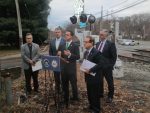Cuomo Signs Bill to Trigger DOT Study of All Grade Crossings

Three local state legislators announced Thursday that Gov. Andrew Cuomo has signed a bill mandating the state Department of Transportation (DOT) study all 5,300 railroad grade crossings in New York and recommend safety improvements.
State senators David Carlucci (D-Clarkstown) and Terrence Murphy (R-Yorktown) and Assemblyman Thomas Abinanti gathered at the Commerce Street crossing in Valhalla, the site of the deadliest crash in Metro-North history in February 2015, to publicize the Railroad Crossing Safety Bill. The lawmakers were joined by Mount Pleasant Supervisor Carl Fulgenzi and Alan Brody, husband of Ellen Brody, the SUV driver whose vehicle was struck by a northbound Metro-North train, which killed her and five passengers aboard the train.
Carlucci said while statistics show car-train grade crossing accidents declining in most other states, in New York that number is trending upward, in large part because the state has been slow to make common-sense safety improvements and make greater use of the latest technology.
“New York, for some reason, has lagged behind the rest of the nation,” said Carlucci, who sponsored the bill in the Senate. “That’s why this sense of urgency is extremely important. This trend that we’ve seen accelerating in New York has to stop. That’s why we’re saying this is urgent.”
The bill calls for the DOT to submit its findings to the legislature and the governor’s office no later than Apr. 1, he said.
Murphy, the Senate co-sponsor, said there are several key areas that the bill addresses. The DOT will examine the design and safety of crossings; whether traffic lights near a grade crossing are properly coordinated with pedestrian and railroad crossing signals; and the feasibility of equipping trains with any available technology to improve safety.
The DOT study will also prioritize safety improvement projects for crossings that need them and serve as a plan to pursue federal funds, Abinanti said. Carlucci added that the Federal Railroad Administration has indicated that money is available to help make rail crossings safer.
The legislators said that when many of these crossings were established, in some cases as far back as 150 years ago, the presence of vehicular traffic and the growth of these communities could not have been foreseen.
“Much has happened since these railroad crossings were established in farmland,” said Abinanti, who sponsored the Assembly bill. “They are now in the middle of busy suburban areas and we have all kinds of modern techniques and technologies that (other) states have employed. Hopefully, this will bring DOT down to talk to the public.”
Alan Brody, who has become an outspoken advocate for increasing grade crossing safety since the accident, said the measure was a good first step toward better protecting the public. However, the public must continue to press for more to be done, including improvements that can be achieved through better signage and technology, he said.
Since the accident, the Town of Mount Pleasant has also made suggestions to DOT about enhancing safety at the Cleveland Street crossing, which is south of Commerce Street, but there has been no response.
Fulgenzi said the legislation was needed to force the railroads and the DOT to seriously consider following through on the improvements that need to be made.
“I’m here all my life. I’ve been crossing these crossings for 62 years,” Fulgenzi said. “Nothing has changed, and it needs to change.”
On Feb. 3, 2015, rush hour traffic, the short distance between the parkway and the crossing and unfamiliarity of the area by the driver may have played a role in the accident at Commerce Street.

Martin has more than 30 years experience covering local news in Westchester and Putnam counties, including a frequent focus on zoning and planning issues. He has been editor-in-chief of The Examiner since its inception in 2007. Read more from Martin’s editor-author bio here. Read Martin’s archived work here: https://www.theexaminernews.com/author/martin-wilbur2007/

